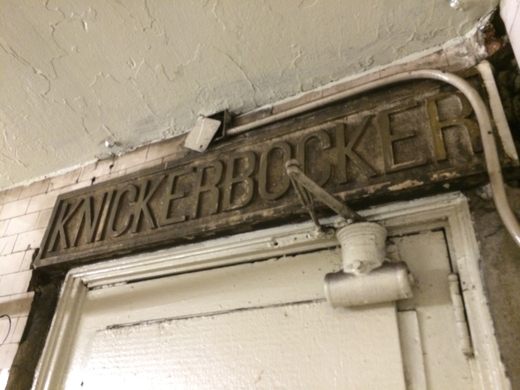The Knickerbocker
Highlights
The Knickerbocker Hotel combines elegant, refined interiors with a prime Times Square location, offering upscale dining, a rooftop bar, and attentive service.
The Knickerbocker Hotel combines elegant, refined interiors with a prime Times Square location, offering upscale dining, a rooftop bar, and attentive service.
"With a rooftop bar just 150 feet below the ball itself, The Knickerbocker Hotel offers an up-close experience with a live DJ, open bar, and a midnight champagne toast."
"Deep in the subway system below Times Square, and passed by thousands of commuters and tourists every day, there’s a white door that goes largely unnoticed. It’s tucked away on the end of the platform of Track 1 on the S shuttle between Grand Central and Times Square-42nd Street, closest to the 42nd Street exit. At first glance, it’s similar to the many doors that can be found in many MTA stations, storing supplies or equipment. But where those lead into utility rooms, offices, and generators, this white door was once a portal into a glamorous world. Atop the door is a faded metal sign which simply says “KNICKERBOCKER,” and behind it lay a secret entrance to the bar of what was once one of New York’s most splendid accommodations: John Jacob Astor’s Knickerbocker hotel. Above ground, on the corner of Broadway and 42nd Street, the Knickerbocker was a Beaux-Arts masterpiece. Built with Astor’s millions in 1906, it had over 500 rooms, with space in the restaurants and bars for 2,000 revelers. Throughout the Gilded Age, the hotel was a centerpiece of Times Square. It was an epicenter of refined elegance, and commonly known as the “42nd Street Country Club.” A 30-foot mural of Old King Cole and his Fiddler’s Three, painted by Maxfield Parrish, hung over the bar, where the bartender Martini di Arma di Taggia is rumored to have invented his famous namesake cocktail in 1912. When Astor died on the Titanic, his son took over. The hotel soon fell out of favor in the Prohibition era. Parrish’s mural was moved to the St. Regis Hotel, and the old building was converted into offices for Newsweek magazine. The hotel reopened in 2015—but so far, there aren’t any plans to bust open the secret back door to what was once one of the city’s finest jewels. Update as of January 2020: Renovations to the tracks currently obscures the view of the secret door. Update as of February 2022: The renovation, which included cleaning the lintel, is complete and the entrance is again visible." - ATLAS_OBSCURA

"Deep in the subway system below Times Square, and passed by thousands of commuters and tourists every day, there’s a white door that goes largely unnoticed. It’s tucked away on the end of the platform of Track 1 on the S shuttle between Grand Central and Times Square-42nd Street, closest to the 42nd Street exit. At first glance, it’s similar to the many doors that can be found in many MTA stations, storing supplies or equipment. But where those lead into utility rooms, offices, and generators, this white door was once a portal into a glamorous world. Atop the door is a faded metal sign which simply says “KNICKERBOCKER,” and behind it lay a secret entrance to the bar of what was once one of New York’s most splendid accommodations: John Jacob Astor’s Knickerbocker hotel. Above ground, on the corner of Broadway and 42nd Street, the Knickerbocker was a Beaux-Arts masterpiece. Built with Astor’s millions in 1906, it had over 500 rooms, with space in the restaurants and bars for 2,000 revelers. Throughout the Gilded Age, the hotel was a centerpiece of Times Square. It was an epicenter of refined elegance, and commonly known as the “42nd Street Country Club.” A 30-foot mural of Old King Cole and his Fiddler’s Three, painted by Maxfield Parrish, hung over the bar, where the bartender Martini di Arma di Taggia is rumored to have invented his famous namesake cocktail in 1912. When Astor died on the Titanic, his son took over. The hotel soon fell out of favor in the Prohibition era. Parrish’s mural was moved to the St. Regis Hotel, and the old building was converted into offices for Newsweek magazine. The hotel reopened in 2015—but so far, there aren’t any plans to bust open the secret back door to what was once one of the city’s finest jewels. Update as of January 2020: Renovations to the tracks currently obscures the view of the secret door. Update as of February 2022: The renovation, which included cleaning the lintel, is complete and the entrance is again visible." - ATLAS_OBSCURA

"Like the St. Regis, this Beaux-Arts hotel was first built in 1906 by John Jacob Astor IV." - Travel + Leisure Editors
"Writer H.L. Mencken called the martini “the only American invention as perfect as the sonnet.” It’s no surprise this classic cocktail was born in a New York hotel bar; like Manhattan, a good martini is strong, dry, and smooth. A bartender at the Knickerbocker named Martini di Arma di Taggia is said to have served hotel regular John D. Rockefeller the drink for the first time."
Madyson Pennington
Jordan Palmer
Joshua Dominguez
Stephen Coakley
Richard P
Kristen
TitanDC
NYerinPhilly

Yessica G.

Laura A.

Chris G.
Stuart A.

Mercedes S.

Doug S.

Rome D.

Marjorie A.

Jolene H.

Gloria M.

Keelan P.
Evan C.
Evelyn H.
Lois M.

Jamie M.

Mandy K.
Larry T.

Lisa F.

Phena L.

Doug S.
Chalse O.

Aaron W.

Alli C.

Flora H.

Kelly B.

Stephanie L.
Bob B.

Min C.

Daniel D.
Rachel F.

Brooke H.

Brittany C.

Jennifer T.
Crystal L.

Yvonne F.

Gail D.
E S.

Fox E.

Kloe K.
Joseph D.

Dana C.

Jose M.

Jodi K.
Richard K.

Karne N.
Maryam R.
Omar P.
Alex T.

Han P.